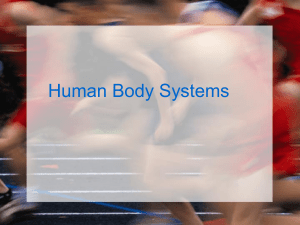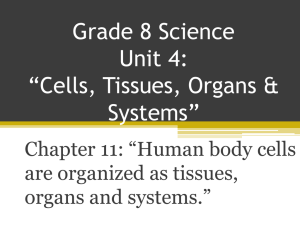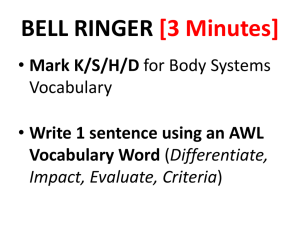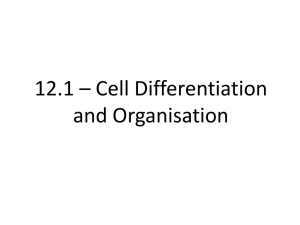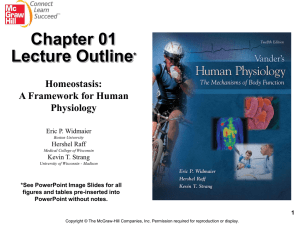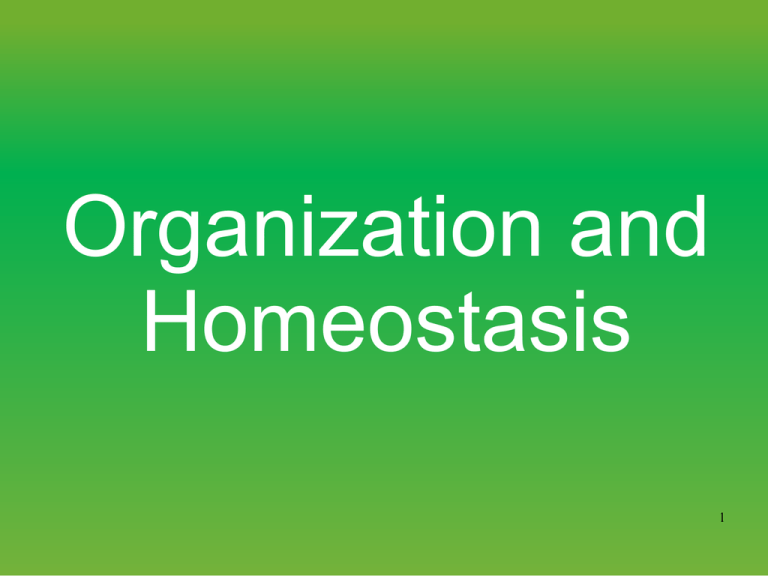
Organization and
Homeostasis
1
Levels of biological organization
Chemical
Cellular
Tissue
Organs
System Level
Organismic Level
2
Levels of Structural Organization
Chemical Level - atomic and molecular
level
Cellular level - smallest living unit of the
body
Tissue level
Group of cells and the materials surrounding
them that work together on one task
4 basic tissue types: epithelium, muscle,
connective tissue, and nerve
3
Epithelial tissue
Functions of the epithelium
SECRETION
PROTECTION
SELECTIVE ABSORPTION
4
Epithelial tissue
Epithelial cells are connected to each other by tight
junctions, adhesion junctions and gap junctions.
Epithelium lies on a basement membrane, which acts
as a scaffolding and anchors the epithelial tissue to the
underlying connective tissue.
5
Cells of the epithelium
6
Cells of the epithelium
7
Cells of the epithelium
8
Cells of the epithelium
9
Connective tissue
Connective tissue connects, protects and supports
other tissues.
The most abundant tissue in vertebratesConnective cells are separated by a collagen-rich fluid
called matrix which varies from solid (in bones) to
semifluid (in cartilage) to fluid (in blood).
10
Types of Connective Tissue
11
Types of Connective Tissue
12
Blood is different from the other
connective tissues
WBC
RBC
Blood has different
functions as:
•Transport of oxygen
•Transport of nutrients
•Body heat regulation
•pH regulation
•Protection
Platelets
Plasma
13
Muscular tissue
Muscular cells contains contractile filaments, actin and
myosin, that move past each other and change the size
of the cell.
Major functions:
•Locomotion of the organism;
•Movement of internal organs.
14
Muscular tissue
15
Nervous tissue
Major functions:
•Sensory input
•Sensory output
•Communication within organs
•Control of muscles and glands
•Homeostasis
16
dendrite
Neurons transmit
impulses
cell body
Neuron cells are composed of:
•A cell body (contain nucleus)
•Dendrites (for input signals)
•An axon (for output signals)
axon
17
Neuroglia cells
Neuroglia cells assist
propagation of the impulse
and provide nutrients to the
neuron.
microglia
astrocyte
oligodendrocyte
Neuroglia cells include
microglia (destroy bacteria
and remove dead cells),
astrocytes (supply nutrients)
and oligodendrocytes
(insulate neurons).
18
Animations and activities
Watch the following animation and write the names of the
animal tissues, organs and organ systems presented:
http://www.tutorvista.com/content/biology/diversity-inliving-world/level-of-organization-hierarchy.php
Read the description of the following tutorial, watch the
animation and answer the quiz:
http://www.hartnell.edu/tutorials/biology/tissues.html
Watch the following animation about the epithelial tissues:
http://www.tutorvista.com/content/biology/tissues/ani
mal-tissue.php
Are there some tissues that you do not know?
19
Organs and organ systems
Organ level - consists of two or more types of primary
tissues that function together to perform a particular
function or functions
Example: Stomach
Inside of stomach lined with epithelial tissue
Wall of stomach contains smooth muscle
Nervous tissue in stomach controls muscle contraction and
gland secretion
Connective tissue binds all the above tissues together
Organ system - collection of related organs with a
common function, sometimes an organ is part of more
than one system
Organismic level - one living individual.
20
Organ systems
Groups of organs that perform related
functions and interact to accomplish a
common activity essential to survival of
the whole body.
Do not act in isolation from one
another.
Human body has 11 organ systems.
21
The skin covers and protects
In humans the skin is divided into two strata: the epidermis
(stratified epithelium) and the dermis (dense fibrous
connective tissue).
A subcutaneous layer, the hypodermis (connective tissue)
connects the dermis with underlying structures.
22
Videos and activities
Watch the following videos:
1) http://www.youtube.com/watch?v=yKAzVC0WcmI
(about skin)
2) http://www.youtube.com/watch?v=9nV_RY2HD7Q
(about skin, with subtitles)
3) http://www.youtube.com/watch?v=cAQpchyTXYo
(a review of cell, transport and tissues)
Read the descriptions on pages 1, 2, and 3, answer
the questions on pages 2 and 3, and solve the quiz
on page 5 at:
http://www.abpischools.org.uk/page/modules/skin/.cfm?
coSiteNavigation_allTopic=1
23
Organ systems work in homeostasis
Several organs of a system work together to carry out a
complex function as:
•Control
•Sensory input and motor output
•Transport
•Maintenance
•Reproduction
24
Control
Nervous system coordinates the body actions and
transmits signals between different locations.
Endocrine system regulates the hormones secretion.
25
Sensory input and motor output
Integumentary system is the attachment site for sensory
receptors and provides environmental information.
Skeletal and muscular systems are responsible for
locomotion in response to nervous system instructions.
26
Transport
Cardiovascular system transports nutrients, gases,
hormones and other substances through the body.
Lymphatic system is a network of conduits carrying the
lymph which returns protein and lipids in excess to the
circulation.
27
Maintenance
Digestive, Respiratory and Urinary systems are
responsible for maintaining the body efficient and constant
through the transformation of nutrients or gases and
purifying the organism.
28
Reproduction
Organs of the reproductive system include the genitalia
(penis and vulva) and a number of internal organs as the
gamete producing gonads (testicles and ovaries).
29
Homeostasis
Defined as maintenance of a relatively
stable internal environment
Does not mean that composition,
temperature, and other characteristics
are absolutely unchanging
Homeostasis is essential for survival
and function of all cells
Each cell contributes to maintenance
of a relatively stable internal
environment
30
Homeostasis
Homeostasis is the maintenance of stable, constant
conditions of the body’s internal environment which
consists of blood and intestitial fluid (tissue fluid).
Homeostasis involves dynamic mechanisms that detect
and respond to deviations in physiological variables from
their “set point” values by initiating effector responses that
restore the variables to the optimal physiological range.
EQUILIBRIUM
31
Homeostasis
All organ systems
contribute to maintain
within normal limits
the internal conditions
as body
temperature, water
content, pH,
Glucose and CO2
concentrations.
32
33
Homeostatic Control Systems
In order to maintain homeostasis, control
system must be able to
Detect deviations from normal in the internal
environment that need to be held within narrow
limits
Integrate this information with other relevant
information
Make appropriate adjustments in order to
restore factor to its desired value
34
Negative feedback
The negative feedback mechanisms is the principal
mechanism in homeostasis and is composed of a
sensor and a reaction center (i.e. blood glucose levels).
Sensor
Control center
effect
Control center
effect
Sensor
35
Animations and activities
Read the description on pages 4, 5, 6, and 7, see the
animation on page 4 and answer the questions on pages 5,
6, and 7 of the document at:
http://www.abpischools.org.uk/page/modules/homeostasis_s
ugar/.cfm?coSiteNavigation_allTopic=1
Read the description on pages 1 and 2 of the document at:
http://www.bbc.co.uk/schools/gcsebitesize/science/triple_aq
a/homeostasis/removal_waste_water_control/revision/1/
Read the description, watch the video and the animation
that can be found at:
http://www.bbc.co.uk/schools/gcsebitesize/science/triple
_aqa/homeostasis/temperature_control/revision/1/
36





